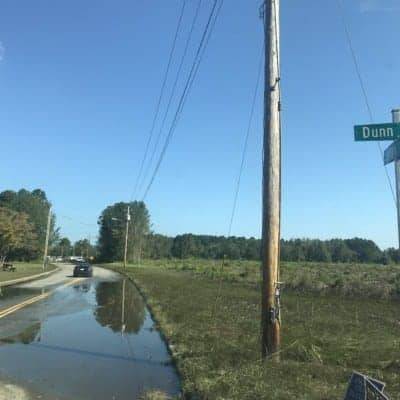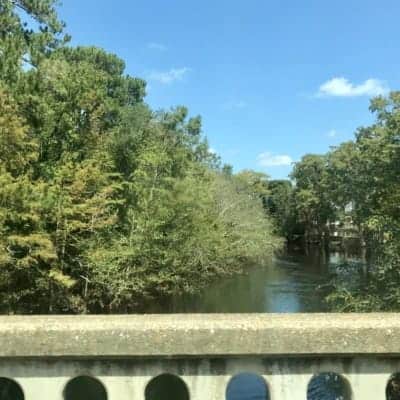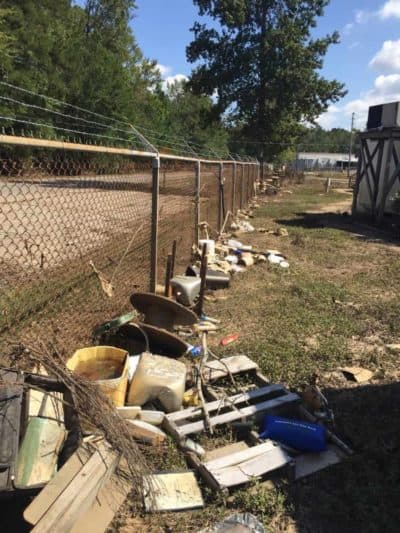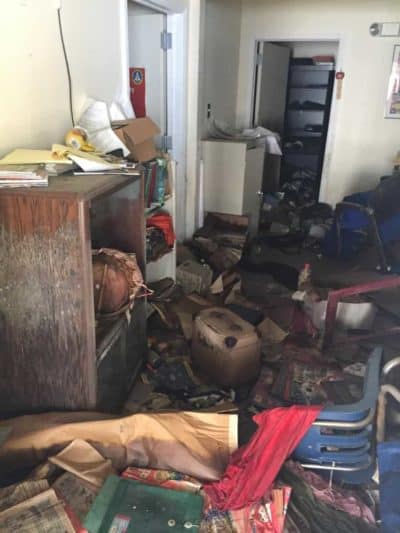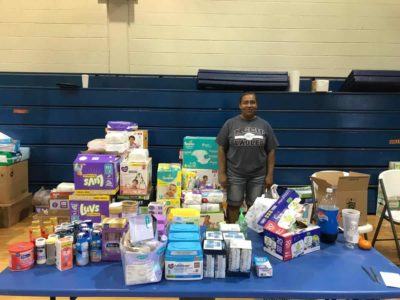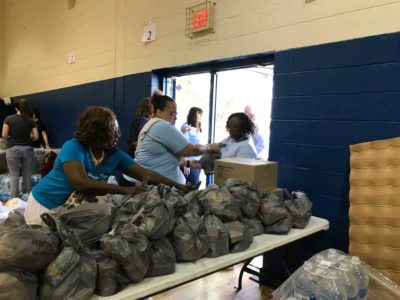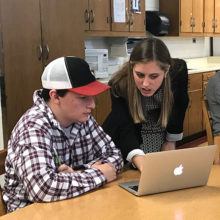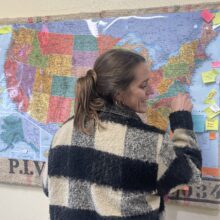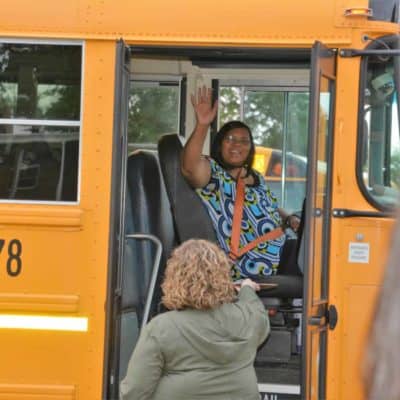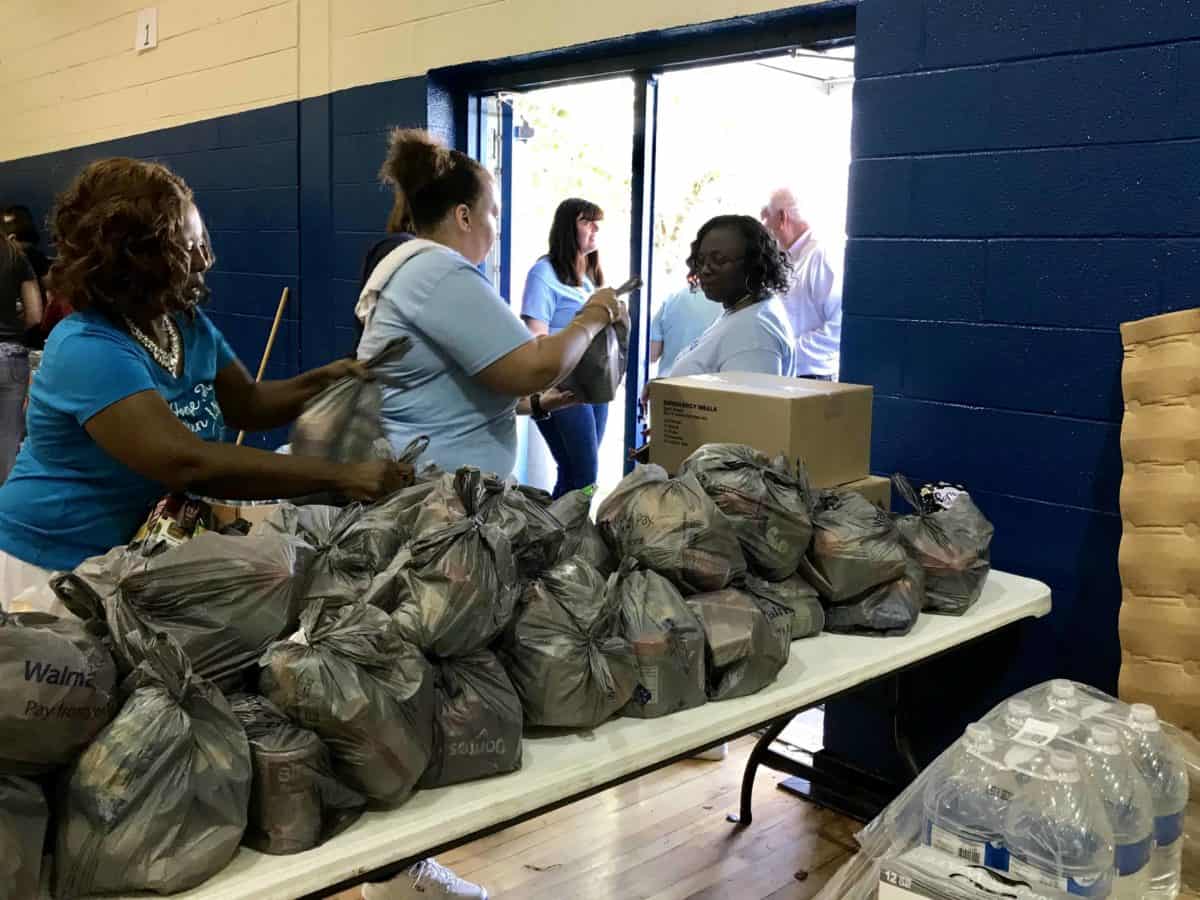
Across the street from Lumberton Junior High School, yards are piled with the remnants of people’s lives — damaged furniture, ripped-out carpet, and bags of possessions that are now trash. A long line snakes around the back of the high school with people waiting to pick up food, toiletries, and other basic necessities. The volunteers at the school tell us they are running out of cleaning supplies.
The people of Robeson County are picking up the pieces after the second major flood in less than two years. When we visited on Wednesday, roads were still closed and the Lumber River remained dangerously high. Many of those who evacuated were only able to get back earlier this week and returned to flooded and damaged homes.
According to Robeson County Administration Public Information Officer Emily Jones, around 60 buildings flooded or were damaged from the storm — and as of Friday morning, around 260 people are still in shelters. Others are staying with friends, family, and neighbors.
Meanwhile, the public schools in Robeson County remained closed this week, and a decision has not been made regarding reopening. University of North Carolina Pembroke reopened on Tuesday, and Robeson Community College students returned to class on Thursday.
Less than a month ago, we visited Robeson County as part of our Awake58 community college tour and met with community college leaders, K-12 educators, students, and members of the Lumbee Tribe. We learned how they collaborate to create better futures for the children of Robeson County. On Wednesday, we talked with those same people about a different kind of collaboration as the community rallies and recovers from Florence.
Coming together after the storm
At first glance, the Lumberton Junior High parking lot seems less than a quarter full. Pulling around back reveals a different scene. Families are lined up collecting donated water, diapers, trash bags, wet wipes, clothing, hot meals, and more. Volunteers are passing out flyers for FEMA instructions and sorting, stacking, and distributing supplies in the gymnasium.
Kindergarten teacher Antoinette Thompson is one of those distributors. “We’re still volunteering because there are still people who are worse off than we are,” she said. She is joined by her teaching assistant, Shontay McNeill, who cannot get into her house and is staying with her pastor while her three children stay with her mother in Goldsboro.
But this is not the first hurricane recovery the community has faced. Superintendent Shanita Wooten, who has lived and worked in Robeson County her whole life, says their experience with Hurricane Matthew made them more prepared for Florence. “When we left work on September 11th, we knew what our responsibility was,” she said.
“I don’t think you can ever be fully prepared, but now this time, before Hurricane Florence came in, we put together a hurricane team, a disaster team, recovery team,” Wooten said. “We brought everyone to the table who would be critical before the storm, during the storm, and after the storm.”
Before the storm hit, the school district organized a “sharing and caring” day where they gave out supplies, clothes, and other items for the students. In the video below, Wooten describes how everyone from maintenance to transportation to child nutrition has been involved in preparing and responding to the storm.
Besides the challenge of locating displaced students, Wooten said the biggest challenges for their community will be ensuring everyone who needs it can get assistance from FEMA, social services, the state, and insurance. Wooten said she is worried some may not get the help they need after two storms: “Some of the ones who received help with FEMA and other agencies, they rebuilt in the same place. So now certain agencies aren’t going to keep funding at the same level, because they keep going back to the flood zone.”
Wooten is also concerned about the impact of the storm on students’ emotional health and learning. In the coming weeks, guidance counselors will talk with students about their experiences, as they did after Matthew. Concerned teachers have created grade-level packets and ACT prep work to give to students at the shelters, and the curriculum and transformation department created “Continue to learn and grow during Flo.”
Robeson County PIO Emily Jones shared, “Our kids need an educational platform that showcases love, support, and compassion.”
The long road to recovery
Down the road in Pembroke, the Lumbee Tribe is assessing the damage to their homes and collecting supplies to distribute to the community. According to the Lumbee Tribe’s asset manager James Jones, approximately 138 of the 417 homes they insure have been damaged as of Wednesday, with about 67 more homes to assess. Some homes flooded, while others were damaged by the strong winds and falling trees. Eleven homes have dropped ceilings, and one home has been condemned after two trees fell on it.
They are worried that they will soon be forgotten. Danielle McLean, attorney for the Lumbee Tribe, said:
“Recovery is not a two week time period. It’s not a month. It’s going to be years. It’s going to take a long time because we haven’t recovered from Matthew.”
Rita Locklear, Project ACCESS Director, and Tammy Maynor, Director of Governmental Affairs, said they are concerned about the impact on families who have been hit twice now in less than two years. Locklear said there were families whose houses flooded during Matthew and who were still waiting for FEMA to lift up their houses when Matthew hit. Locklear and Maynor said many families who had just finished rebuilding after Matthew had their homes flooded again, only worse this time.
“They had rebuilt some of the houses, they had lifted some of the houses, but those flooded,” Locklear said. “Communities that have been devastated at least now twice, I’m not sure the families are going to continue to stay there.”
Locklear and Maynor are not sure if families will leave because of the devastation or stay because of their attachment to the land. “There is an attachment to family, property, land,” Maynor said. “Our people moved to the river, that’s where we came from,” Locklear added. “You lived next to the river, you fished in the river, you washed your clothes in the river, you lived on the river. And many of our people still had homes there.”

Preparing for back to school
While the district has not announced when students are going back yet, Superintendent Wooten aims to get students back next week. She does not want students to be out of school for three weeks.
However, reopening schools is a difficult task. On Wednesday, bus drivers drove their bus routes, reporting any road closures that could affect routes. The child nutrition department is busy disinfecting and sanitizing freezers at the schools and placing food orders. The district’s IT system also remains down. On Wednesday, technology specialists were removing damaged servers from the district administration building that flooded a second time.
At Robeson Community College, staff and faculty were waiting to see how many students showed up on Thursday and throughout the next few weeks as the classes resume. Public Information Officer Dennis Watts shared that enrollments decreased after Matthew, with those in the nursing department stating they lost 50 percent of their students.
During a meeting earlier this week, staff and faculty were adamant about providing supports for students recovering from Florence. The college is trying to help students meet basic needs by arranging hot meals, inviting additional counselors on site, ramping up efforts at the on-campus food pantry, and more. They are modifying the school schedule to make up time, so students have the opportunity to make up days missed.
“Bottom line is folks’ homes still have water in them,” Watts said. “Folks don’t have clothes, cars, food, housing, that kind of stuff. Do I think we will lose some students? Yes.”
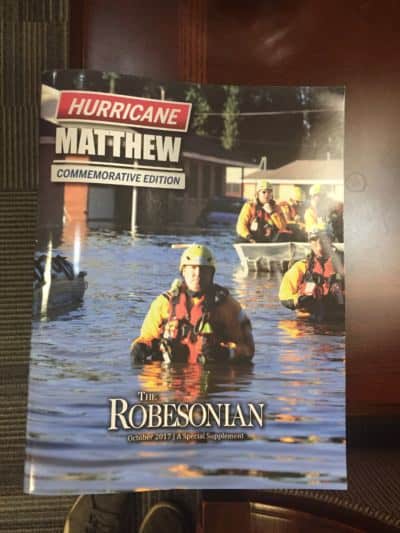
During Florence, Robeson Community College served as “a specialty medical shelter,” according to Watts. The facility on campus has radiography, respiratory equipment, and surgical tech equipment and could “serve as an operating room if needed,” he said.
Throughout the storm, the college kept in touch with students via email, Facebook, traditional media, and a texting service called Regroup that students could sign up for. “Social media is probably the one that is most effective,” Watts said, echoing comments we heard at the high school and the Lumbee Tribe about how they used social media to communicate.
Watts said they also felt more prepared this time around. “Things are getting back to normal maybe a little more quickly for some folks,” he stated. “The flooding was worse, but people were a little more prepared for it.”

